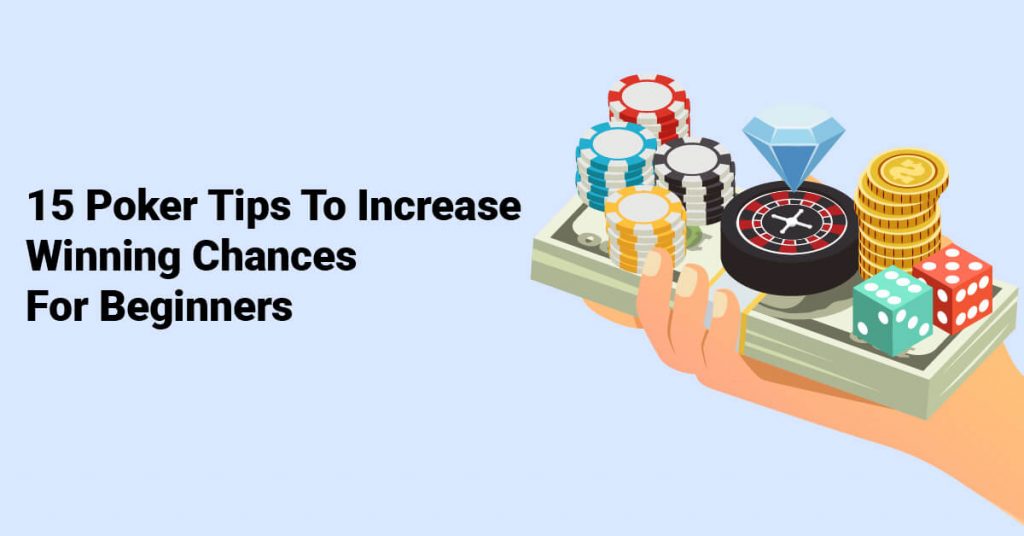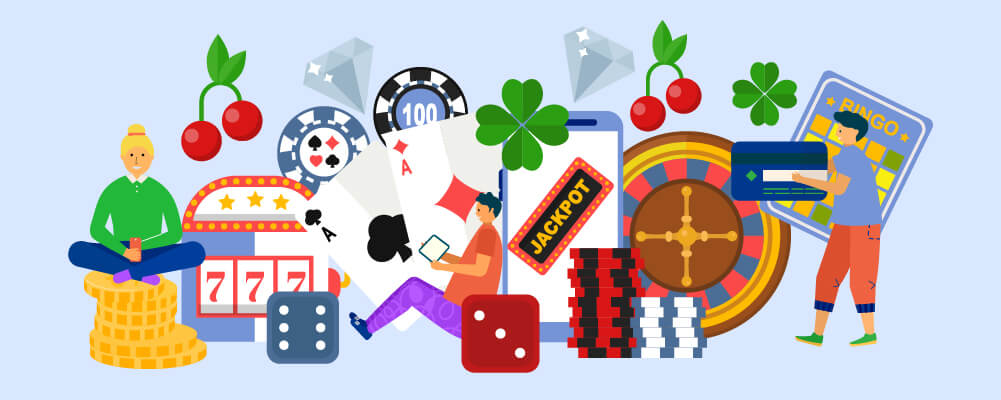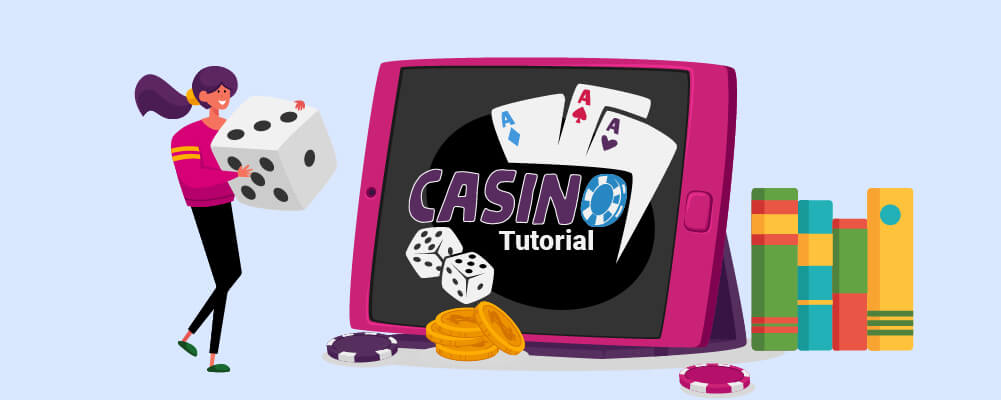
Unlike other gambling games you can find at a casino, poker is not all about chance. There are solid and reliable ways to win a table and increase your money pots. In fact, some people are so good at the game that they become professional poker players!
This article is aimed at beginners and is structured to make you play less of a guessing game. Instead, we are going to help you with strategy.
Getting the upper hand can put you in a league higher than other beginners, making you the most likely winner at any newbie table.
Table of contents
- 15 Poker Tips To Increase Winning Chances For Beginners
- Learn The Rules and Poker Hands Ranking
- Start By Playing Low Stakes Poker
- Mathematics Is The Key To A Winning Strategy
- Ignore Gut Instincts and Emotion
- Never Play Out of Desperation To Win
- Learn The Art of Bluffing
- Learn When To Fold
- Learn Poker Terminology
- Study The Games of The Best Poker Players
- Look To Improve Your Hand Reading Skills
- Manage Your Bankroll Effectively
- Set Aside Money In Case of a Losing Streak
- Learn The Game Theory Optimal (GTO)
- Learn How Position Affects Chances of Winning
- Consider Using A Poker Tracking Program
- Summary
15 Poker Tips To Increase Winning Chances For Beginners

In some games, it’s the participation that counts, but with poker, it’s all about winning.
Our 15 tips below can help you learn the game, understand your hand, understand the opponent’s hand, and know when to save your copper.
1. Learn The Rules and Poker Hands Ranking
The first step to beating any game is to understand the rules. Poker is no different.
In poker, there are 10 hand rankings to aim for. If you want to create a believable poker face and not waste time remembering the rules, then you need to memorize these rankings.
In order of best hand to worst, the rankings are:
- Royal Flush – This is when your cards are a 10, Jack, Queen King, and Ace, but all from the same suit.
- Straight Flush – This hand could have any cards, but they are all in sequential order and of the same suit. For example, 2, 3, 4, 5, and 6 of hearts.
- Four of a Kind – Four of the cards have the same number/face. For example, 10 of diamonds, 10 of spades, 10 of hearts, 10 of clubs, and a 4.
- Full House – For this hand, you need to have 3 of a kind and 2 of a kind, using the same rules as four of a kind, above. For example, two Jacks and three 7s.
- Flush – All five cards need to be from the same suit.
- Straight – Like a straight flush, the cards need to be in sequential order, however, they can be from any suit. For example, 3, 4, 5, 6, 7.
- Three of a Kind – Like an incomplete Full House, the three of a kind hand has three cards with the same number/face while the other two are unmatched. For example, three 9s, one 6, and one Queen.
- Two Pairs – In this hand, two cards have the same number/face, and another two have a different number/face to the first pair, but they match each other. The last one matches nothing. For example, two 5s, two Kings, one Jack.
- One Pair – In this hand, two cards have the same number/face, but no other cards match. For example, two 5s, one King, one Jack, one Queen.
- High Card – This hand has a high card, like an Ace, King, Queen, or Jack.
Understanding and remembering these rules without thinking twice will allow you to understand your place at the table and will create accurate guesses about what hands can beat you.
2. Start By Playing Low Stakes Poker
Whenever you learn anything new, you have to be prepared to fail. Poker is no exception. To make sure you don’t lose too much money, you should begin playing by making the stakes low. This way, if you do lose (and you will while you’re starting out), you won’t have lost too much money.
There are three main reasons for starting low, and it’s not just about saving money.
The first reason is to make you comfortable. If you lose on a low stakes beat, you’ll feel deflated, sure, but you won’t feel so deterred that you’ll have stopped learning. If you play with high stakes, you will likely stop studying the table and will instead rush to save your money. This means you won’t be learning and instead will be relying on untrained instinct.
The second reason is because players who run with high stakes will have a high skill level. If you start at the low stakes end, you will be around people with the same level of skill as you, or worse. This means you can wrap your head around their failures and your own as you learn the same. Playing with people who are too over-skilled will only leave you confused and out-matched.
The last reason is to help you see the game from every angle. Playing with low stakes will allow you to stay in the game for longer. You can see how low-ranked hands could win a game and understand how intimidation alone could make everyone at the table back down. You can play around at a low stakes table to learn what play is best in what scenario.
3. Mathematics Is The Key To A Winning Strategy
Lots of new players follow their gut when it comes to poker instead of following the numbers.
The math of poker comes down to the “Outs,” the “Odds,” and the “Expected Value.” If you manage to understand and learn these strategies by heart, you’ll be sure to up your odds at winning the table.
The “Out” is the card that would complete your hand for a high rank. Every time a new card comes into play (or the “flop”), you need to be counting your outs. This will allow you to understand how to get the best out of your hand.
For example, If your hand has a King and a Queen of hearts, and the table shows an 8 and 2 of hearts, with a 7 of spades. You just need one more heart to complete your hand and earn a Flush. Because there are a possible 9 other hearts in the deck, you have a lot of “outs” that could help you win.
However, if your hand was a 5 of clubs and a 9 of hearts, and the table had a 6 of diamond, 8 of spades, and 2 of hearts, then your outs need a 7 of any suit to complete a Straight. There are only ever four 7s in a deck at all times, so your odds of receiving a 7 in the next flop is low.
When it comes to the pot odds, the mathematical hurdles to get the exact numbers can be overwhelming. Instead, use the outs as a guide. The more outs you have available to complete your hard, the better the odds are.
The expected value of a table is another math-heavy thought process, but the equation looks like this:
Expected Value = (Win% x Win$) – (Lose% * Lose$)
For example, if every player has to pay $10, and you are playing against 4 people, then the winner will receive $40. With 4 players, you have a 25% chance of winning and a 75% chance of losing.
Expected Value = (0.25 x $40) – (0.75 * $10)
Expected Value = 10 – 7.5
Expected Value = 2.5
Having a positive expected value is what you need to aim for, as it means you have a likelihood of winning. Poker is a game of stamina, and we expect to lose every now and then. With a 2.5 EV, we know that a player needs to play 4 times or more to win back that original $10 to play. This is because $10 divided by 2.5 EV is 4. We will put this formula below to make it easier to find.
How Many Times You Should Play = Lose$ / Expected Value
4 Times= $40 / 2.5 EV
The higher the EV number, the less you’ll need to play to win your money back.
4. Ignore Gut Instincts and Emotion
Like we said before, most new players follow their gut instincts but looking at the math involved in poker, there is no room for guessing. Human beings are hopeful creatures that like to put a lot of spiritual energy into an item to help us win; unfortunately, this doesn’t work.
Putting so much energy into one card that could help us win makes us ignore the 40 other cards in the deck that could be more profitable.
Before putting all of your thoughts and motivation behind your gut feelings, assess them first. Is that card really going to help you win, or is there another option on the table?
5. Never Play Out of Desperation To Win
Poker is a game about the long journey and not about an instant or constant win. Many new players read up about playing styles but get impatient and lose their credibility. Most new players follow the tight-aggressive playing style that many websites suggest to follow. Ideally, this game style should help you win, but in reality, it is a hard one for new players to master.
The idea is that you fold quickly when a hand isn’t good enough to win, and as soon as a hand is high ranking, you force all the other players to bet big. The important part of this strategy is to bin all of the bad hands. New players, however, become impatient with the lack of playing and find themselves desperate to win anything. They might find a low one pair and go for it. By raising everyone’s bets, a couple of people back out, but when the last round begins, the player ultimately loses because a one pair isn’t likely to beat anything.
Players like this often blame their hand, but the real culprit was their boredom. If you become desperate to win, you will be more likely to lose.
6. Learn The Art of Bluffing
One of the classic and well-known features of poker is the bluff. Bluffing is when a player pretends that they have a good chance of winning to persuade the other players into folding, even though their cards aren’t great.
When it comes to beginners, the best advice we can give you is to avoid bluffing, at least for the first few months of playing. This is because you need to learn how to play the game and your own gaming style and achieve success in the process. Adding bluffing into the mixture too early can cause you to lose games necessarily and dampen your enthusiasm for the gamble.
If you think you are ready to start bluffing, the best people to start off with are players you have already been against. You will know this opponent and understand how they play. For example, if you notice that a player doesn’t pass a certain financial limit, then you can push them to the limit and make them doubt their hand.
The next thing you need to do is figure out how many opponents are in your way. You will have to persuade them all to fold, so the fewer players left standing, the better.
These are just a couple of beginning tips to bluffing; there is so much more that you can learn.
7. Learn When To Fold
Although the ultimate aim is to win, you need to learn when to fold. It might seem like backing out of a game, but in reality, you are saving your money for games you can win.
The overall aim is to be successful, so remember to aim for the long stretch and not the instant gratification. As you are starting off on the lower bets, the other players will be less likely to bluff. This means that people raising the stakes likely have a good hand. If your hand is low on the ranks, then there is no point in hanging on.
That being said, not every player will play the same. There are maniac players, aggressive types, and those you cannot read the table. In times like this, you need to understand their pattern of behavior while sticking to what’s on the board. If no one has raised the stakes, then there is no harm in staying in the game, but if the money is piling in and your cards aren’t strong, know when to back away.
8. Learn Poker Terminology
Players who have been in the game for years will have a vast knowledge of all the terminology. If you do not know the slang and shorthand, you will automatically be singled out as a new player.
If you’re playing amongst friends, this will not be an issue, but if you try to enter a tournament (no matter how low priced), you will become the target of aggressive play.
We suggest learning all of the terminologies, like a second language, so you can keep up with the quick conversation and bat away any vulture players sniffing out the new meat.
Although not all of these terms are still in use, being aware of their meaning will teach you what the professionals consider important.
For example, a “baby” is a card that can make a poker hand, but it has the lowest possible value. Having a word to define this phenomenon shows you that poker players see this type of hand in play often enough that it deserves its own word. In a sentence, this could look like:
“Come on; even a baby will do!”
9. Study The Games of The Best Poker Players

At this point in your poker game, you cannot expect to beat a champion player, but you can absolutely learn from them. No matter if they are playing with high stakes or low ones, these professionals will be sitting down to a whole different game to you.
They will use their cards in ways that you wouldn’t have thought of and will be counting their odds as they go. Watching the experts, you will be able to see amazing methods in action and see their real-time effects.
You can find these expert games on free sites like Youtube, so you won’t lose out on money to learn from the best. Once you’ve watched a game from start to finish and seen a particular move that you want to copy. Stop the videos and start practicing.
Learn one method at a time, and keep practicing until it starts to stick. Keep referring back to the video that started off your interest to revise for your own games, and once you think you can handle it on your own table, only then should you search for another learning point.
10. Look To Improve Your Hand Reading Skills
Reading hands is the action of calculating the possibility of your opponent’s hands based on their previous actions.
If a player is at the beginning of the round, they will have a bigger range than someone at the end. If we play at the beginning, we need to keep our chips tight, as we don’t know what our opponents have.
If a player raises the stakes at the beginning, this means that they think they have a strong hand. Maybe a face card or a pair already.
Further in the game, reading your opponent’s hands can be more complicated, as you have to follow their betting patterns and previous plays. You cannot judge based on their reaction alone.
To understand your opponent’s hand, be aware of everything they do; even if you have flopped, you can watch them play out their hand and learn about their tells. Figure out if your opponent is a tight player or a loose player. Do they have a casual flick in their hand, which stops when things get serious? Do they continue to play a raise out of aggression rather than their hand?
Use all this time, especially when you’re out of the round, to understand how each player studies the table. Once you’ve figured out how a player plays, it will be a lot easier to guess their strategy and counteract their bets.
The best way to learn about someone’s hand is through studying their preflop, their flop, their turn, and their river. Looking at each of these details, you can figure out a player’s estimated value in their hand and if they think the gamble is worth it.
11. Manage Your Bankroll Effectively
From all of our advice so far, you should expect to play hundreds of games to truly understand your own playing style and how to read other people’s. However, this type of feat will come at a cost, the genuine cost of money. Before you get too excited and start getting into loads of tables, you need to give yourself a spending limit. This spending limit cannot just be how much you can spend on the table, but how much you can gamble in a day or week, or month.
Whatever limits you give yourself, be sure that they are realistic and do not harm your financial obligations. Then you need to stick to this limit. Never go beyond it.
Even if you find yourself on a winning streak, do not spend more than your limit. Professional gamblers always have financial advisors on their teams to help them set back when they are on a roll. The thrill can be so intense that the desire to keep playing could help you lose everything. So instead, plan ahead.
A very common way to manage your bankroll is to set spending limits and winning caps. For example, in your low-stakes bet, you might have a spending limit of $50, which you can use for a month. In the month, you might win money and add it to your kitty, or you might lose money from your kitty. If you reach $0, you cannot add more money into the pot bankroll until your next payday, however, if you reach $100, you can take out $50 and put it into something fun or sensible in your life (like savings or a new game).
When the next month comes along, you can top up your bankroll to reach $50 again, so you always start off with the same amount. This could mean topping up by $5 or topping up by $40.
Although this type of management is commonplace, it is still only an example. Knowing your own finances, create a management style that will realistically and actively help you keep in control.
12. Set Aside Money In Case of a Losing Streak
Using the previous step as an example, you should hopefully be settled and prepared for when you start on a losing streak. Although no one can win every single poker game, a lot of people can lose every one they play. Keeping your money limited to a small pocket allows you to stay financially stable even when luck is against you.
Realistically there are two options available to you when you are on a losing streak. You can either stop playing and admit defeat, or you can keep playing until your money runs out.
If you have a managed fund like we talked about before. Then playing until you reach $0 isn’t the worst thing in the world. However, If you already managed to push your kitty into the $200, seeing it reach $0 can be gut retching. You have to decide if getting away before you hit zero is a better option than letting the money run out.
Whatever you do, be sure to figure out why you are losing so much. Research other strategies, see if you need to drop down a league, and ask your friends for feedback.
13. Learn The Game Theory Optimal (GTO)
GTO is a playing strategy that is designed to help you win. The idea is that you learn to play the perfect game of poker so that when the other players make mistakes, the only person it will benefit is you.
This game style is very different to the Expected Value method we spoke about before, as it instead uses bluffing or semi-bluffing to help with the strategy.
The method around Game Theory Optimal is detailed and difficult, which is why you should only attempt it after understanding and utilizing the Expected Value method.
If you learn this method, we recommend you practice in low stakes or practice rounds before raising the bets. This is so you can learn to calculate the hands in front of you before playing against people with more stamina and quicker movements.
Eventually, both of these methods will feel like second nature to you, but only when you have studied them to death.
14. Learn How Position Affects Chances of Winning
One of the most important factors to consider when playing poker is your position in the table. You are more likely to win money when you play later in the round. This means you should aim to use your best hand and become more active when you do not start off the games.
If and when you do start off around, you should aim to play tight. This is because you will not know how the other players at the table feel about their cards until your go has been and passed. Playing tight stops you from telling everyone what you have and keeps you stable.
The most profitable position to be in is the seat right before a new round begins. This is because you will have seen everyone’s play and can use that information to understand how they fit in this table.
When you are practicing your strategy and game style, be sure to practice your positions too. Remember to be observant in every position but be cautious in early positions while being more daring in late ones. Using these changes in strategy to put off your opponents too. With more strategy in play, your opponents will find it hard to predict your next move and, therefore, your bluffs.
Adding these differences to your game will make you a more varied player, but it will take a long time to achieve. This is why we keep saying to practice, as you can easily fall from one strategy to the next if left untrained.
15. Consider Using A Poker Tracking Program

Tracking programs aren’t designed to help you cheat. They don’t disproportionately help one player more than another, however, they do show you and everyone else playing the game what each player’s track record is. Before the games start, you can pull up your opponents’ stats and see if they are tight players, if they are a high roller, if they play often or if they spend forever making their turn.
This information can help you figure out how they play and what the best way to beat them is. Of course, if you can see this about your opponents, then they can see it about you too.
These programs are often found in online games, and they are perfect for new players trying to understand the game beyond their home table. If you only play with one table, then you can quickly become comfortable learning their tells and understanding how they play. It can make you soft and forget the detailed difficulties.
Use these tracking programs to help you find specific players that you haven’t encountered before or often lose to. You can then learn to beat them or stabilize your winnings against them.
You can even use these tracking programs to track your own play style. You can test out different play methods and use the tracking system to see which one you have a better overall result from. Then you can pull these methods into your regular table. Either way, the tracking system is a great way to point out your own flaws and then search how to fix them.
Information is the key to success.
Summary

If you want to take poker seriously, these tips for beginners are the way to start. Once you have learned what the terms mean, how to calculate your opponents’ hands, and how to figure out the most likely outcome for yourself on a table, you will be able to beat any other player at a beginner’s level.
This level of play is already known by those who play at a semi-professional level. They are also often missed by casual gamblers. Remember that it is normal to make mistakes, but use every opportunity to learn and fine-tune your strategy.
